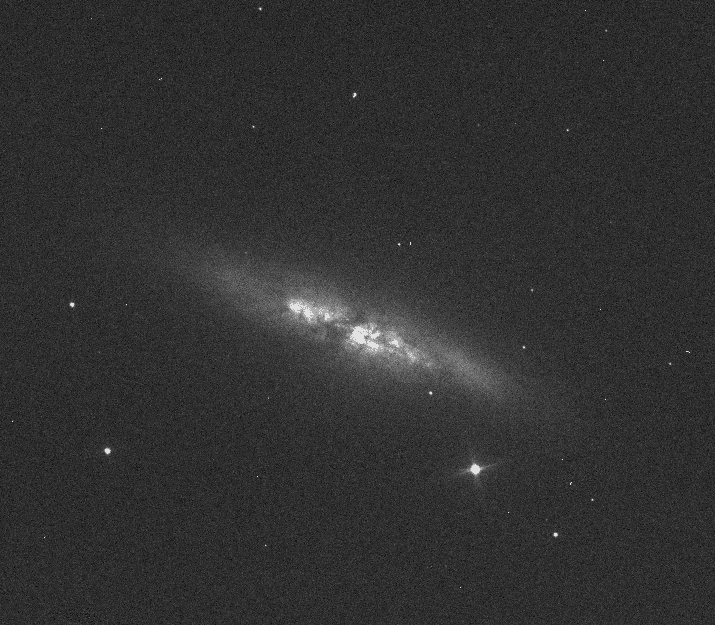Emily Lakdawalla • Jan 22, 2014
Super-close supernova in M82
The astronomy world is all a-twitter this morning over the discovery of a new supernova in M82, a galaxy that's in our astronomical backyard, "only" 12 million light-years away. And early word is that it appears to be a Type Ia supernova, the kind that's used as a standard candle to measure the expansion of the universe. According to Nick Howes at Remanzacco Observatory, "This is the closest supernova to Earth since the Supernova 1987A and the closest supernova Type Ia since SN 1972E." Even better, the discovery was made by students working with astrophysicist Steve Fossey at University College London.

Remanzacco Observatory shared a nice pair of comparison images of M82 before and after the supernova:

I'm no astronomer, so to tell you more of the story of the discovery I'll send you to SkyMania, and to fill in a little more background I'll send you to Universe Today, and to tell you how to observe it yourself (you'll need a small telescope, but it may brighten enough to be visible in binoculars) I'll send you to Sky & Telescope.
Supernovas are one kind of natural phenomenon that set me daydreaming. So enormous, so mind-bogglingly violent, this little flash could have destroyed whole solar systems, and sterilized many more. And yet out of their destruction, rebirth: the seeding of their galaxy with the heavy elements from which life-building molecules and planet-building rocks are made. Life out of death, annihilation begetting creation, the goddess Kali incarnate.
My daydreaming made me wonder: if we're receiving photons from this supernova, will we receive particles, now or in the future? I asked my astronomer colleagues on Twitter, and in short, the answer is no.
@elakdawalla I talked to the IceCube people, and the backgrounds are too strong - too hard to ID neutrinos from it.
— Matthew R. Francis (@DrMRFrancis) January 22, 2014
@elakdawalla Which is too bad! I'm told we could distinguish between explosion mechanisms by neutrino counts.
— Matthew R. Francis (@DrMRFrancis) January 22, 2014
@elakdawalla I think not. R^2 is a big big thing 12 million LY away. Also, I don't think material gets recycled between galaxies.
— Andy Rivkin (@asrivkin) January 22, 2014
@elakdawalla Also, 12 million years for light to travel. If material is moving 0.01 c (still super duper fast), that's over 1 Gy.
— Andy Rivkin (@asrivkin) January 22, 2014
@DrMRFrancis @elakdawalla Any cosmic rays it produces could take >10M years and come from the wrong direction, so let's not plan on those.
— Thomas Stroman (@StarsMathMan) January 22, 2014
@elakdawalla Ia give fewer neutrinos than II. @uw_icecube says "At the distance of M82, we can't pick the supernova neuts out of the noise"
— Kristin Block (@MarsMaven) January 22, 2014
Then this tweet from Space Telescope Science Institute's Max Mutchler made me sit up and take notice:
Progenitor of the M82 #supernova was probably detected in our 2006 @HubbleTelescope mosaic. Start digging: http://t.co/WW0C2U0lNR
— Max Mutchler (@maxmutchler) January 22, 2014
Here's the Hubble mosaic. Click through twice to see it in all its 22 Megabytes of glory. But if you want to dig through to find the supernova's progenitor, it's best to start with the original data.

Astronomers are now asking for help from amateurs who may have imaged M82 in the last week:
It will help a lot, we'll include you in the publications! MT @chrislintott Astrophotographers - check images of M82 taken in the last week
— Brad Tucker (@btucker22) January 22, 2014
Treat your astronomer friends kindly over the next few days, they may be especially sleep-deprived.
Can't sleep star is exploding.* *12 million years ago
— Katie Mack (@AstroKatie) January 22, 2014
The Time is Now.
As a Planetary Defender, you’re part of our mission to decrease the risk of Earth being hit by an asteroid or comet.
Donate Today

 Explore Worlds
Explore Worlds Find Life
Find Life Defend Earth
Defend Earth

